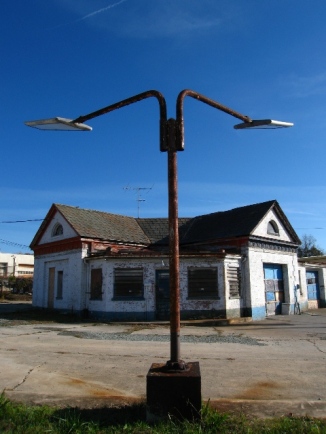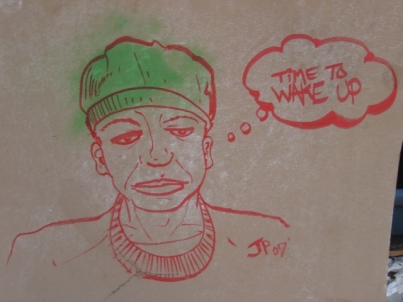From any perspective native to the world of electronic images, Jean Baudrillard’s theories of simulation have perhaps never seemed more like simple description, even to the point of banality. And yet their implications remain uncertain and underdeveloped. Of particular relevance to our project is the new relationship he attributes to map and territory in a hypermediated environment:
Abstraction today is no longer that of the map, the double, the mirror or the concept. Simulation is no longer that of a territory, a referential being or a substance. It is the generation by models of a real without origin or reality: a hyperreal. The territory no longer precedes the map, nor survives it…it is the map that precedes the territory…it is the map that engenders the territory…It is the real, and not the map, whose vestiges subsist here and there, in the deserts which are no longer those of the Empire, but our own. The desert of the real.
And later:
For it is the difference which forms the poetry of the map and the charm of the territory, the magic of the concept and the charm of the real. This representational imaginary, which both culminates in and is engulfed by the cartographer’s made project of an ideal coextensivity between the map and the territory, disappears with simulation.
In other words, the map form becomes productive of the territory it purports to represent, pushing unmediated reality to the margins. This map is coextensive with the reach of ‘Empire,’ or global political and economic control. The world becomes ‘post-referential.’ Is this the aesthetic — and therefore, if one fully accepts this discourse — the literal function of Google Earth? This interpretation would certainly match the kinds of changes Google Earth makes to the ‘standard’ indexical map of colored lines and place names that we are accustomed to, and which perhaps reached its peak in complexity and functionality with programs like MapQuest and Google Maps. By using genuine satellite photographs, user-generated 3-D models, and user-uploaded photos, Google Earth approaches the simulation rather than the abstract referential marking of real space. The distance between direct experience and the view framed by the digital interface shrinks. Knowledge of the world is not given by this experience, but by information provided by Google, the branding of the planet by a single corporate logo.
But to say that simulation extinguishes ‘ the real,’ that “signs of the real” are substituted for “the real itself,” is either to veer dangerously close to a kind of magical thinking, whereby reality immediately and effortlessly conforms without remainder to social/technological determination, or to argue that previous modes of epistemological justification have been infinitely suspended — that it becomes impossible to “prove the real.” Baudrillard seems to argue the second while flirting with the first. While he presents the regime of simulation as a liberation from all imposed order based on the “divine referent,” this suggests that the process does not need to be reproduced, that it is automatic, privileges no one, and that its particular details are inscrutable. What this odd conclusion reflects is a widespread confusion as to where the emphasis should land in the many definitions of ‘reality’ — is reality primarily the universal (divine?) system of reference? Or is its source direct, personal experience? Is its fundamental determination political-epistemological (a product of competition between empiricism, rationalism, etc.) or phenomenological? Put in these terms, the problem appears to have no solution. Let us try looking elsewhere.
The logic of simulation, especially as manifested in digital technology, is also sometimes referred to as ‘virtual reality.’ In the post-phenomenological tradition of philosophy spearheaded by Henri Bergson and come into its own with Gilles Deleuze, the virtual is something like an effect separated from its cause. Another way of putting it is that it is something that has not yet entered the realm of ordinary cause and effect. For Bergson ‘virtual’ describes the realm of pure memory, a discontinuous collection of images that, through unpredictable routes, work their way back into consciousness, whether by focused recollection or something like Proust’s involuntary memory. The virtual then mediates (as memory) our experience of reality, which in turn suggests that human consciousness is essentially mediated by virtual ‘images’ even prior to all technology.
Theoretically, we said, the part played by consciousness in external perception would be to join together, by the continuous thread of memory, instantaneous visions of the real. But, in fact, there is nothing for us that is instantaneous. In all that goes by that name there is already some work of our memory, and consequently, of our consciousness, which prolongs into each other, so as to grasp them in one relatively simple intuition, an endless number of moments of an endlessly divisible time. (Matter and Memory)
Consciousness is both the ‘work of memory’ and, through concentration, the extension of individual moments within the temporal flow of memory-laden experience, leading to the ‘simple intuition’ that allows the other moments to be organized. From this state of comprehension, the spatialized system that we call ‘knowledge’ can be derived. This picture is complicated further by Bergson’s claim that matter itself is also made of ‘images.’ The difference between mediated consciousness and immediate experience of matter then involves a dual potential of the image, and not a fundamental ontological division between subjective perception and objective existence. What this in turn suggests is that all experience, whether mediated only by memory or also by technology, is equally ‘real,’ and that reality is nothing other than the procession of images. The difficulty is in relating the memory-image to the matter-image without slipping back into the terms of subjective\objective opposition.
Deleuze condenses this relation into an image that is simultaneously virtual and actual (that which unproblematically exists), and contends that this dual image is the ‘nucleus’ of reality, or as he puts it in his second book on cinema, “The indiscernability of the real and the imaginary, or of the present and the past, of the actual and the virtual, is definitely not produced in the head or the mind, it is the objective characteristic of certain existing images which are by nature double” (69). One could argue that it is an experience of the cinema which allows Deleuze, and perhaps Bergson as well, to make such observations. In the cinema every image is at once a bit of matter, a memory inscribed on it, and part of a technological medium. If writing also removes the monopoly on memory by consciousness, cinema captures and objectifies its temporality. The movies at once represent, repeat, and reframe ‘the work of consciousness.’ Immersed in cinematic images, Deleuze is able to say, “Subjectivity is never ours, it is time, that is, the soul or the spirit, the virtual” (82). Time is not internal to the subject, the subject is internal to time. Space, on the other hand, is consumed at a rate of 24 frames per second.
If we follow new media theory in understanding digital representation as a ‘remediation’ or reframing of old media via the computer interface (see Jay David Bolter and David Grusin, also Lev Manovich), then we can understand how the representational strategies of Google Earth are an evolution and/or repurposing of cinema. Where the cinema condensed space into movement and time, the basic vocabulary of the computer image is the graph, the diagram, the map – the visual presentation of already-mediated information. In Google Earth, every satellite image can contain multiple user-generated images, as well as words. Every image is simultaneously a database. Time is not presented indirectly by a sequence of movements in space, since Google Earth’s images are presented as always already available. Only the camera moves. New data — electronic memory, if you like — emerges in virtual space, according only to the actions of anonymous users, of which the present user counts as one. Virtual space is then one of absolute openness to ‘becomings’ in the form of alterations and uploading of information, a space opened up in time, inside the realm of electronic images. Movement is controlled neither by the will of a director/cinematographer nor by the movement of a subject, but by the actions of the user within parameters determined by the interface. This ‘deterritorialized’ cinematic apparatus — functioning via pan, zoom, and tilt — is able to undermine all hierarchies of scale, allowing the user unlimited access to a virtual space. Nothing remains to mediate our control over the aesthetic of mapping Google Earth makes possible; our actual limitations are only those of the program itself.
This brings to mind certain hypothetical statements made by Bergson about the unity of subject and object that would follow if memory were ‘eliminated,’ and Deleuze on the possibilities of cinema opened up by modern European filmmakers such as Alain Resnais, what he calls the ‘time-image,’ as distinct from the ‘movement-image’ or the classical cinema of Sergei Eisenstein and Buster Keaton:
The cinema is going to become an analytic of the image, implying a new conception of cutting, a whole ‘pedagogy’ which will operate in different ways…Even when it is mobile, the camera is no longer content sometimes to follow the characters’ movement, sometimes itself to undertake movements of which they are merely the object, but in every case it subordinates the description of a space to the functions of thought. This is not the simple distinction between the subjective and the objective, the real and the imaginary, it is on the contrary their indiscernability which will endow the camera with a rich array of functions, and entail a new conception of the frame and reframing. Hitchcock’s premonition will come true: a camera consciousness which would no longer be defined by the movements it is able to follow or make, but by the mental connections it is able to enter into. And it becomes questioning, responding, objecting, provoking, theorematizing, hypothesizing, experimenting, in accordance with the open list of logical conjunctions (‘or,’ ‘therefore,’ ‘if,’ ‘because,’ ‘actually,’ ‘although…’) or in accordance with the functions of thought in a cinema-vérité [cinema of truth] which as Rouch says, means rather truth of cinema (23).
In the movement-image, time is subordinate to movement, as the rhythm of an ordered sequence of shots that follow physical movement. In the time-image, movement is subordinate to time, as the interval created by non-sequential, discontinuous camera movement, cutting, and splicing becomes the direct presentation of time (roughly analogous to the effect of the DJ’s free manipulation of the record). In the digital image as framed by a computer, a purely synthetic space-time is subordinate to thought and the commands of the user, whose attention is fully absorbed by it. The camera has grown a brain in the form of the interface, and this is what the user manipulates, the extension not of his or her senses, but of his or her thoughts in relation to the senses; the interface is always already ‘theorizing’ the images it presents. Shifting between layers, marking places, these are all theoretical adjustments, the emphasizing of one data set over another. Finally, anything resembling an ‘interval,’ a gap in presentation, vanishes. Virtual space is itself a gap, a hole in reality from which the impossible can be prepared, and can, as the ‘externalization’ of speculative thought, expand the limits of what is considered possible. With Google Earth, the mapped locations literally consist of an ‘actual image’ and a ‘virtual image,’ though the boundary between them is always porous.
If we think the virtual and the actual as having replaced the old dichotomy between possible and real, then we can no longer say that reality has collapsed into hyperreality, but that the space of the virtual has materialized within the space of the actual. Just as the cinema materialized the virtual, subjective flow of temporality, digital media materializes a virtual space within the flow of images, by means of which they can be broken down and reconstituted. In Google Earth, a location can be digitally mapped, imaged, described, historicized, advertised, criticized, and ignored, by multiple users for multiple reasons. This does not make the place ‘itself’ disappear, but concentrates and externalizes our memory of it to contain an unprecedented amount of information, which we can in turn alter, not only for ourselves but for others. It is just as much a political process as constructing a new housing complex, or passing a zoning ordinance, even though (for the moment) the stakes are not as high. This is what is meant today when we repeat Deleuze’s theory of virtual and actual as “distinct but indiscernible.”
So we must agree with Baudrillard when he argues that the logic of splits, oppositions, and resistances can no longer be considered fundamental. Perhaps they remain fundamental to individual, local experience – but then ‘raw’ experience can no longer be thought of as fundamental. And this is why cannot stop with Baudrillard, whose melodramatic bid for universality only indicates the limited, particular nature of his account. Now requires the use of intensive, sharp-edged analytic concepts, with clearly defined parameters that can be used to traverse and ultimately burst apart the old hierarchies. The proper object for a thought and practice both liberated and constrained by technology is not resistance to various enemies (untruth, corrupt policies, exploitation, inequality, etc.) but the ‘real abstractions,’ liberated and constrained by technology, that provide those enemies with their means of existence.
Baudrillard, Jean. Simulations. NY: Semiotexte, 1983.
Bergson, Henri. Matter and Memory, tr., N.M. Paul and W.S. Palmer (New York: Zone Books, 1994).
Bolter, David Jay and Richard Grusin. Remediation: Understanding New Media. Cambridge: MIT Press, 1999.
Deleuze, Gilles. Cinema 2: The Time-Image, trans. Hugh Tomlinson and Robert Galeta (Minneapolis: University of Minnesota Press, 1989).
Manovich, Lev. “The Language of New Media.” (Cambridge, MA: MIT Press, 2001).







